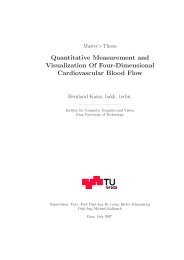CashFlow, A Visualization Framework for 3D Flow - Studierstube ...
CashFlow, A Visualization Framework for 3D Flow - Studierstube ...
CashFlow, A Visualization Framework for 3D Flow - Studierstube ...
- No tags were found...
Create successful ePaper yourself
Turn your PDF publications into a flip-book with our unique Google optimized e-Paper software.
Implementation4.3. SoMultiDataNode4.3 SoMultiDataNodeFigure 4.7: <strong>Cash<strong>Flow</strong></strong> Data <strong>Flow</strong> Model - MultiData node: Accessing virtual array using the attributesoffset, inc, length, label and data type (not shown)The purpose of the MultiData node was already mentioned in section 3.6 onpage 51. This section focuses on the kind of data stored in this node.• Raw DataThis is data on permanent storage created by numerical simulations like– computational fluid dynamics (CFD) systems or– finite element methods (FEM).Also a lot of medical units produce reasonable data like– computer tomography (CT) or– magnetic resonance imaging – tomography (MRI)(MRT)(MR) and– positron emission tomography (PET). PET data is very similar to FEMdata, because both create 3x3 tensors as output.• Intermediate / Process / Derived DataDerived or intermediate data is generated by most algorithms. Often it is usefulto store that data be<strong>for</strong>e it is processed or rendered directly. The most frequentlyderived data in scientific visualization are:– gradient, often used instead of the normal vector– stream lines– iso surfacesThe reason <strong>for</strong> storing that in<strong>for</strong>mation is:– reuse instead of recalculateSome in<strong>for</strong>mation like gradient would otherwise be calculated again bydifferent algorithms.74





